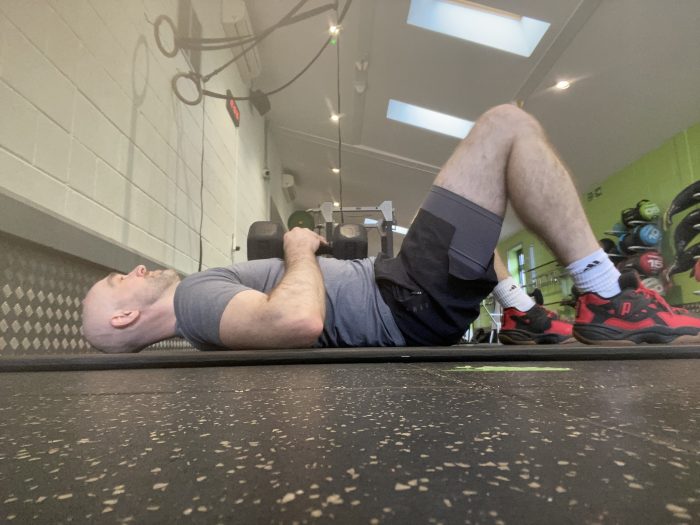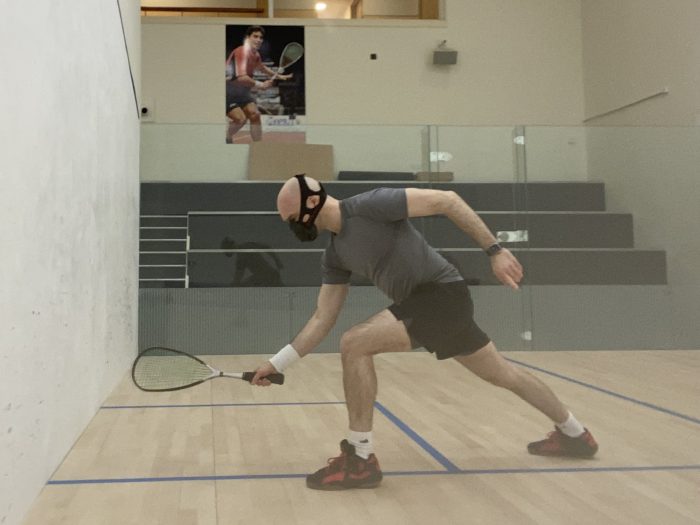Breath training – often described as the ‘new frontier’ of athletic performance – is becoming increasingly high profile, with many professional athletes such as Erling Haaland and Iga Switek embracing science-backed techniques to improve their performance. In the squash world too, players such as Amanda Sobhy and Victor Crouin are reaping the benefits of incorporating breath training into their routines. But what ARE the benefits of breath training, and how can it improve your performance on court? Read on to find out more and for some practical tips to get you started…
Please note that breath training (in particular breath holds) should not be undertaken when pregnant or if you suffer from high blood pressure. If in doubt consult your doctor before attempting any of the below techniques.
1. Breath Training improves aerobic performance
Our lungs are the ‘engine’ of athletic performance – their function is to draw oxygen into our body to fuel our muscles and cells whilst also expelling waste products.
It is therefore critical that we breathe as efficiently as possible to optimise oxygen delivery – unfortunately however breathing pattern disorders are highly prevalent, even within athletic populations, risking premature breathlessness, muscle fatigue and sub-optimal performance (Chapman, et. al, 2016).
Functional breathing patterns also play an important role in posture and spinal stabilisation by creating intra-abdominal pressure – where breathing disorders are present, functional movement capacity is adversely affected and the risk of injury is increased.
Breath training optimises breathing biomechanics, and also ensures that we’re able to increase our tolerance to carbon dioxide – whilst CO2 is often considered to be simply a waste product, it actually plays an important role in facilitating the release of oxygen from haemoglobin to our cells. If we’re offloading too much CO2, the efficiency of that release becomes compromised.
How can you start?
The simplest way to start is by ensuring that you’re breathing through your nose AT ALL TIMES when training at sub-maximal intensity (i.e. HR zones 1- 3). It won’t be easy, especially at first, but it’s worth it…a 2018 study of recreational runners indicated that nasal breathing is 22% more efficient than mouth breathing! (Dallam, 2018)
2. Breath Training improves anaerobic conditioning
Of course, when we play squash, we regularly exceed our aerobic threshold and tap into our anaerobic energy system.
Hypoxic (low oxygen) / hypercapnic (high CO2) breathhold training improves anaerobic conditioning by exposing our body to increased blood acidosis.

Breathing against the resistance of a dumbbell helps to strengthen respiratory muscles.
In turn, our body adapts by improving lactate tolerance and our ability to buffer excess hydrogen ions (responsible for the ‘burning’ sensation in our muscles when they start to fatigue at high intensities) – in turn improving our endurance and rate of recovery.
Indeed, a 2018 study of national-level rugby players found that players practising breath holds after exhalation twice a week increased their repeat sprintability capacity by 64% vs. a marginal 6% increase for the control group (Fornasier-Santos et. al, 2018).
This type of training can be particularly useful when you’re recovering from injury and want to prevent loss of anaerobic conditioning – or simply when you want to expose your body to a hypoxic / hypercapnic state without putting too much stress into the musculoskeletal system.
How can you start?
Breath hold training can be very intense and is best taken under guidance from an experienced breath coach. However, a simple way to begin is by introducing breath holds into runs or walks. Start small with 5 x holds (after exhalation) of 5 – 10 paces with c.30s in between holds. Then repeat with a higher number of paces for each hold (e.g. 20 – 25…or more!) and longer breaks between rounds – it should feel challenging but not too extreme. It’s important to return to nasal breathing after each round to maintain the hypoxic / hypercapnic effect.
3. Breath Training increases respiratory muscle strength
When our respiratory muscles tire, our body redirects blood flow from our legs to our breathing muscles (as they are deemed a ‘higher priority’) – this reduction in blood flow (known as ‘blood stealing’) causes fatigue and negatively impacts athletic performance.
Functional (nasal) breathing, as well as specific exercises to increase respiratory muscle strength, can help to mitigate against this metaboreflex by ensuring that we don’t need to breathe as ‘hard’ for a given level of exercise intensity, reducing respiratory muscle fatigue.
Furthermore, as I’ve already mentioned above, our respiratory muscles – in particular the diaphragm – play an important role in core stabilisation. Therefore when we strengthen those muscles we can develop greater core stability, improving movement efficiency and helping to mitigate against the risk of injury.

Using a Sports Mask while training creates resistance to air flow and increases tolerance to carbon dioxide.
How can you start?
As when training any muscle, to increase respiratory muscle strength we need to introduce increased resistance or load for the muscles to overcome. Nasal breathing is a good start as it creates greater resistance to air flow vs. mouth breathing. To take it a step further, you can explore single nostril breathing e.g. during recovery from intense exercise (between ghosting sets is the perfect opportunity). You could also try out a Sports Mask – though be warned it’s pretty intense!
4. Breath Training regulates the nervous system
Each cycle of the breath is linked to our autonomic nervous system – with each inhalation we stimulate our ‘fight or flight’ sympathetic response, increasing our heart rate, whilst each exhalation does the opposite by stimulating our ‘rest and digest’ parasympathetic response and lowering our heart rate.
Therefore by manipulating the breath we are able to directly influence our nervous system – calming ourselves when we feel agitated or using the breath to help us get ‘in the zone’ when we need to (see below).
In this way breath training techniques can be powerful tools to help combat stress and anxiety and maintain nervous system balance so that you’ll be at your peak when going into your game. They will also support effective rest, recovery and down-regulation after a hard training session or match.
How can you start?
If you’re feeling anxious or nervous, a simple technique is to lengthen your exhalation, thus exacerbating the calming effects of parasympathetic nervous system stimulation. Begin by establishing a light breath in and out of your nose, and then start to extend the outbreath so that it’s longer than the inhalation (e.g. breathe in for 3 or 4 seconds, exhale for 5 or 6 seconds). When lying on your back, this technique is also helpful for down-regulation and recovery after training or a hard match.
5. Breath Training focuses the mind
Mental focus is as much of a skill as perfecting your backhand drop. Unfortunately however, we spend most of our lives in a state of distraction (hello, social media) meaning that we are actually training our brains for a lack of focus.
Breath training is a great opportunity to counter the effects of the multiple distractions we are subjected to on a daily basis by improving mental focus – like any aspect of our nervous system the brain will respond and adapt to this training stimulus over time (a phenomenon known as neuroplasticity), helping you to be mentally sharper and more alert on court.
How can you start?
Simply paying attention to your breath as you practise any of the techniques above is a good start (don’t worry if your mind wanders – just start again!). Practising breath holds is a particularly good opportunity to bring your mind into focus. Try 2 x small breath holds (e.g. 5 – 10 seconds) from a seated or reclining position followed by 5 x strong breath holds (30 – 60 seconds with c. 60 seconds between rounds) – this is a great practice to take 5 – 10 minutes before you go on court to get in the zone (there are physiological benefits to this practice too but that’s a post for another day!)
So ends this summary of some of the key benefits that breath training can bring to improve your performance on the squash court (there are more!).
As a trained Oxygen Advantage® breath coach, Matt can support you in harnessing the power of breath training for the significant benefits that it can offer your squash game – so if you’re looking to introduce some of these approaches and techniques into your training, or would simply like to understand more about them, then don’t hesitate to get in touch.
 Matt Gill,
Matt Gill,
Oxygen Advantage® breath coach, Functional Range Conditioning® Mobility Specialist, and Mindfulness-Based Stress Reduction facilitator.
Sign up to the SquashSkills newsletter
Get world class coaching tips, straight to your inbox!